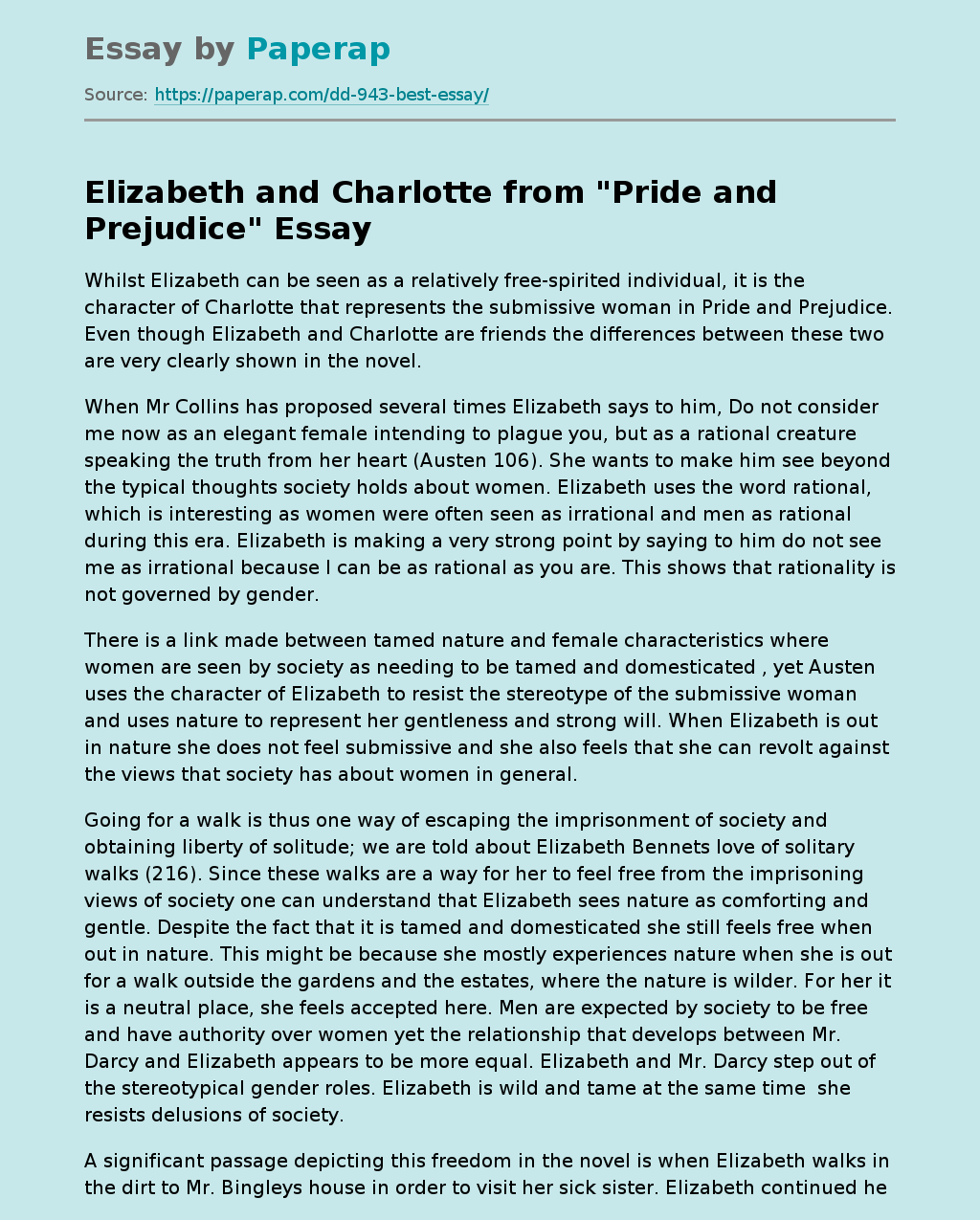Elizabeth and Charlotte from "Pride and Prejudice"
Whilst Elizabeth can be seen as a relatively free-spirited individual, it is the character of Charlotte that represents the submissive woman in Pride and Prejudice. Even though Elizabeth and Charlotte are friends the differences between these two are very clearly shown in the novel. When Mr Collins has proposed several times Elizabeth says to him, Do not consider me now as an elegant female intending to plague you, but as a rational creature speaking the truth from her heart (Austen 106). She wants to make him see beyond the typical thoughts society holds about women.
Elizabeth uses the word rational, which is interesting as women were often seen as irrational and men as rational during this era.
Elizabeth is making a very strong point by saying to him do not see me as irrational because I can be as rational as you are. This shows that rationality is not governed by gender. There is a link made between tamed nature and female characteristics where women are seen by society as needing to be tamed and domesticated , yet Austen uses the character of Elizabeth to resist the stereotype of the submissive woman and uses nature to represent her gentleness and strong will.
When Elizabeth is out in nature she does not feel submissive and she also feels that she can revolt against the views that society has about women in general.
Going for a walk is thus one way of escaping the imprisonment of society and obtaining liberty of solitude; we are told about Elizabeth Bennets love of solitary walks (216).
Since these walks are a way for her to feel free from the imprisoning views of society one can understand that Elizabeth sees nature as comforting and gentle. Despite the fact that it is tamed and domesticated she still feels free when out in nature. This might be because she mostly experiences nature when she is out for a walk outside the gardens and the estates, where the nature is wilder. For her it is a neutral place, she feels accepted here. Men are expected by society to be free and have authority over women yet the relationship that develops between Mr. Darcy and Elizabeth appears to be more equal. Elizabeth and Mr. Darcy step out of the stereotypical gender roles. Elizabeth is wild and tame at the same time she resists delusions of society.
A significant passage depicting this freedom in the novel is when Elizabeth walks in the dirt to Mr. Bingleys house in order to visit her sick sister. Elizabeth continued her walk alone, crossing field after field at a quick pace, jumping over stiles and springing over puddles with impatient activity and finding herself at last within view of the house, with weary ankles, dirty stockings, and a face glowing with warmth of exercise.Austen uses nature, the mud, the fields, the rain and the puddles as a revolt against the control of society. The nature described in this passage is different, since the mud, the rain and the fields are not things that can be controlled by human beings. They are part of the environment; they are unrestrained and not subject to any masculine control.
This is especially apparent if one compares them to Mr. Darcys house or his garden where everything is tamed, controlled and thoughtfully constructed. Elizabeth is not seen as ladylike according to the views of society in the novel. First of all she walks alone and that is not appropriate for a woman to do during this era. Either a male family member or a senior female family member should always accompany a woman. Secondly she walked to the house, which is considered unacceptable in this society since ladies often travelled by carriage when they went somewhere. Another significant point is that it was raining and that it was very dirty meaning that Elizabeth herself would get dirty. A lady should always look her best and act ladylike; running around in the dirt is not at all how a proper lady should act.
Furthermore, this becomes more obvious when she arrives at the 25 house and Mr. Bingleys sisters are appalled that she came alone, walking in the mud and also by her muddied appearance. For us as readers it is quite the opposite, because we sense some kind of freedom in Elizabeths behaviour. She ignores the prejudices concerning how a woman should act and does as she pleases and enjoys doing this. She revolts against the idea of the typical woman and shows that women can also be impulsive and do things on their own, that they do not need to be protected, that they are not afraid to get dirt under their nails and that if faith was put in them, they would manage fine on their own. All they lack is the freedom to act as they choose, because the society that they live in has different views on the behaviour of men and women.
Elizabeth and Charlotte from "Pride and Prejudice". (2019, Dec 20). Retrieved from https://paperap.com/dd-943-best-essay/

